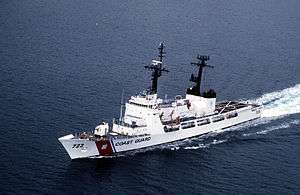Hamilton-class cutter
The Hamilton-class cutter was the largest class of vessel in the United States Coast Guard until replaced by the Legend-class cutter, aside from the Polar-class icebreaker. The hull classification symbol is prefixed WHEC. The cutters are called the Hamilton class after their lead ship, or "Secretary class" because most of the vessels in the class were named for former Secretaries of the Treasury (with the exception of "Hero-class cutters" Jarvis, Munro and Midgett).
.jpg) USCGC Hamilton (WHEC-715), lead ship of the Hamilton class | |
| Class overview | |
|---|---|
| Name: | Hamilton class |
| Builders: | Avondale Shipyards |
| Operators: | See Operators |
| Succeeded by: | Legend-class cutter[1] |
| In commission: | 1965 – present |
| Planned: | 12 |
| Completed: | 12 |
| Active: | 12 (3 United States, 2 Bangladesh, 2 Nigeria, 3 Philippines, 1 Sri Lanka, 1 Vietnam) |
| General characteristics | |
| Type: | High endurance cutter |
| Displacement: | 3,250 metric tons |
| Length: | 378 ft (115 m) |
| Beam: | 43 ft (13 m) |
| Draft: | 15 ft (4.6 m) |
| Installed power: |
|
| Propulsion: |
|
| Speed: | 29 kn (54 km/h; 33 mph) |
| Range: | 14,000 nmi (26,000 km; 16,000 mi) |
| Endurance: | 45 days |
| Complement: | 167 and can carry up to 186 |
| Sensors and processing systems: |
|
| Electronic warfare & decoys: | 2 × MK 36 SRBOC launcher system |
| Armament: |
|
| Aircraft carried: | 1 × MH-65 Helicopter |
| Aviation facilities: | Flight deck and Hangar |

Design
The Hamilton-class cutters were designed to be a highly versatile platform capable of performing various operations, including maritime law enforcement, search and rescue, oceanographic research, and defense operations.[2] Because of their endurance and capabilities, the Hamilton-class cutters commonly deployed with Carrier Battle Groups.[3] They were built with a welded steel hull and aluminum superstructure. The Hamilton-class cutters hull was designed with a V cross section, and through tank testing the hull was expected to survive and stay afloat longer after suffering damage.[4] They are powered by a Combined Diesel or Gas (CODOG) system consisting of two diesel engines and two gas turbines, and have controllable-pitch propellers, they were the first U.S. military vessels with combination diesel or gas turbine operation. Equipped with a helicopter flight deck, retractable hangar, and the facilities to support helicopter deployment.
Combat Suite
The Hamilton-class cutters were designed and built during the Cold War, due to this they were originally equipped for anti-submarine warfare, with the capability to find, track and destroy enemy submarines.[5] When constructed, they were armed with 5"/38 naval gun, two 81 mm mortars, two .50 caliber machine guns, two MK 10 Hedgehogs, two MK 32 torpedo tube systems, and Nixie torpedo countermeasures. During the 1980s and 1990s the cutters were modernized under the Fleet Rehabilitation and Modernization (FRAM) program, during this they replaced the 5"/38 gun with the MK 75 76 mm naval gun, upgraded the MK 32 Surface Vessel Torpedo Tubes to Mod 7, and upgraded the cutters air and surface search radars, sonar, electronic surveillance measures (ESM) suite and installed MK 36 SRBOC launchers.[6] During the modernization of the cutters the U.S. Navy saw the program as a low cost and easy way to use the cutters as a valuable force multiplier with trained crews that could be called upon during war, after the completion of FRAM, a joint Navy/USCG board decided further upgrades to the cutters armament would be implemented, including the installation of Harpoon anti-ship missiles and a MK 15 Phalanx CIWS. The Harpoon anti-ship missiles were fitted to multiple cutters of the class but only one cutter, the USCGC Mellon, fired harpoon missile in January 1990.[7] After the collapse of the Soviet Union, the joint Navy/USCG board decided there was no military threat to require the installation of anti-ship missiles and anti-submarine weapons on board cutters, and subsequently removed the weapons.[8] After the removal of the ASW weapons, the Coast Guard installed MK 38 25 mm chain guns on both sides of each cutter. Currently the Hamilton-class cutters are equipped with the Coast Guards SeaWatch command and control system, which combines navigational, tactical, surveillance and communications into one situational awareness picture, replacing the cutters outdated Shipboard Command and Control System.[9] Missile defense is handled by the MK 36 launchers and the Phalanx CIWS.
History
The 378' WHEC cutter program was initiated in the 1960s, they were intended to fulfill both Coast Guard peacetime and wartime requirements, and serve alongside the current large cutters to meet current and future Coast Guard high endurance cutter requirements.[10] Construction at Avondale Shipyards on the lead ship, the Hamilton, began in the 1960s, the cutter was commissioned on March 18, 1967. Originally the Coast Guard planned to build 36 Hamilton-class cutters, but due to the termination of the ocean stations program they reduced the number of planned cutters to 12.[11] During the Vietnam War multiple Hamilton-class cutters would support Operation Market Time, during the war the cutters would provide patrol duties, boardings and inspections of North Vietnamese and Viet Cong ships and boats, conduct naval gunfire support missions, and provided medical assistance to Vietnamese civilians.[12] Beginning in the 1980s and ending in 1992, the entire class was modernized through the FRAM program. The program included updates and changes to the cutters weapons, sensors, addition of a hangar, engine overhauls, and improved habitability. Throughout their service cutters would also participate in other conflicts and military operations such as Operation Urgent Fury, Operation Vigilant Sentinel, Operation Deny Flight, and Operation Iraqi Freedom.[13][14][15] In March 2007, cutters Hamilton and Sherman intercepted the Panamanian-flagged fishing vessel Gatun in international waters and were able to recover 20 metric tons (20 long tons) of cocaine, with an estimated street value of $600 million retail. The seizure was the largest at sea drug bust in US history.[16]
Ships in class (by homeport)
| Ship Name | Hull No. | Builder | Laid down | Launched | Commissioned | Decommissioned | Fate |
|---|---|---|---|---|---|---|---|
| Munro | WHEC-724 | Avondale Shipyards | 18 February 1970 | 5 December 1970 | 27 September 1971 | ||
| Boutwell | WHEC-719 | 12 December 1966 | 17 June 1967 | 24 June 1968 | 16 March 2016 | Transferred to the Philippine Navy on 21 July 2016 as BRP Andres Bonifacio (FF-17) | |
| Chase | WHEC-718 | 26 October 1966 | 20 May 1967 | 11 March 1968 | 29 March 2011 | Transferred to Nigerian Navy on 13 May 2011 as the NNS Thunder (F90) | |
| Hamilton | WHEC-715 | January 1965 | December 18, 1965 | March 18, 1967 | March 28, 2011 | Transferred to the Philippine Navy 13 May 2011 as BRP Gregorio del Pilar (FF-15) | |
| Jarvis | WHEC-725 | 9 September 1970 | 24 April 1971 | 4 August 1972 | 2 October 2012 | Transferred to the Bangladesh Navy on 23 May 2013 as BNS Somudra Joy[17] | |
| Rush | WHEC-723 | 23 October 1967 | 16 November 1968 | 3 July 1969 | 3 February 2015 | Transferred to the Bangladesh Navy on 6 May 2015 as BNS Somudra Avijan[18] | |
| Morgenthau | WHEC-722 | 17 July 1967 | 10 February 1968 | 10 March 1969 | 18 April 2017 | Transferred to Vietnam Coast Guard on 25 May 2017 as CSB 8020[19] | |
| Sherman | WHEC-720 | January 25, 1967 | September 3, 1968 | 23 August 1968 | March 29, 2018 | Transferred to the Sri Lanka Navy on 27 August 2018, recommissioned 6 June 2019 as SLNS Gajabahu (P626)[20][21] | |
| Dallas | WHEC-716 | 7 February 1966 | 1 October 1966 | 11 March 1968 | 30 March 2012 | Transferred to the Philippine Navy on 22 May 2012 as BRP Ramon Alcaraz (FF-16)[22] | |
| Gallatin | WHEC-721 | 17 April 1967 | 18 November 1967 | 20 December 1968 | 31 March 2014 | Transferred to Nigerian Navy on 7 May 2014 as NNS Okpabana (F93)[23] | |
| Mellon | WHEC-717 | 25 July 1966 | 11 February 1967 | 9 January 1968 | |||
| Midgett | WHEC-726 | 5 April 1971 | 4 September 1971 | 17 March 1972 | Earmarked for transfer to the Vietnam Coast Guard upon decommissioning in 2020. | ||
Operators






See also
References
- Reed, John (23 May 2011). "End of an Era, USCG Retiring Hamilton Class Cutters - Defensetech". Defensetech. Archived from the original on 3 September 2017. Retrieved 1 June 2017.
- "WHEC 378' Hamilton class". www.globalsecurity.org. Retrieved 20 October 2019.
- "THE CUTTERS, BOATS, AND AIRCRAFT OF THE U.S. COAST GUARD" (PDF). uscg.mil. Retrieved 20 October 2019.
- "HAMILTON (1967)" (PDF). media.defense.gov. Retrieved 20 October 2019.
- "The Morgenthau Experiment: Platform for progress". coastguard.dodlive.mil. Retrieved 20 October 2019.
- Coast Guard Oversight: Hearings Before the Subcommittee on Coast Guard and Navigation of the Committee on Merchant Marine and Fisheries, House of Representatives. U.S. Government Printing Office. 1981. p. 87. Retrieved 20 October 2019.
- "Mellon History". www.pacificarea.uscg.mil. Retrieved 20 October 2019.
- "The History and Legacy of the United States Coast Guard Cutter BOUTWELL (WHEC 719)" (PDF). media.defense.gov. Retrieved 20 October 2019.
- "Coast Guard Develops Indigenous Technologies for Cutters". www.afcea.org. Retrieved 20 October 2019.
- U.S. Coast Guard Authorizations: Hearings Before the Committee on Commerce, Science, and Transportation. U.S. Government Printing Office. 1981. p. 22.
- "Coast Guard Cutter Design" (pdf). media.defense.gov. Retrieved 20 October 2019.
- Tulich, Eugene N. (January 26, 2012). "The United States Coast Guard in South East Asia During the Vietnam Conflict". USCG Historian's Office. Archived from the original on November 11, 2013. Retrieved October 20, 2019.
- "The U.S. Coast Guard in Grenada". www.navalhistory.org. Retrieved 20 October 2019.
- "Coast Guard Cutter Morgenthau to be decommissioned Tuesday". coastguardnews.com. Retrieved 20 October 2019.
Morgenthau was the first U.S. Coast Guard cutter to deploy to the Persian Gulf. Participating in Operation Vigilant Sentinel,
- "Guardians of the Gulf: A History of Coast Guard Combat Operations in Support of Operation Iraqi Freedom, 2002-2004" (PDF). media.defense.gov. Retrieved 20 October 2019.
- "Coast Guard Seizes 43,000 Pounds of Cocaine". washingtonpost.com. Retrieved 20 October 2019.
- Mazumdar, Mrityunjoy (4 June 2013). "Former Coast Guard Cutter Jarvis Transferred to Growing Bangladesh Navy". defensemedianetwork.com. Archived from the original on 23 September 2015. Retrieved 2 November 2015.
- ‘Somudra Avijan’ handed over to Bangladesh Navy Archived July 22, 2015, at the Wayback Machine
- MarEx (25 May 2017). "U.S. Delivers Patrol Boats, Cutter to Vietnam". Maritime Executive. Archived from the original on 26 May 2017. Retrieved 26 May 2017.
- "USCG transfers decommissioned cutter to Sri Lanka". Archived from the original on 6 September 2018. Retrieved 6 September 2018.
- "President commissions U.S. Coast Guard Cutter given to Sri Lanka Navy as SLNS Gajabahu". ColomboPage. 6 June 2019. Archived from the original on 7 June 2019. Retrieved 6 June 2019.
- "Next Navy ship to be named after Corregidor hero". ABS-CBN News. Archived from the original on 27 November 2015. Retrieved 23 December 2015.
- Martin, Guy (8 May 2014). "Nigeria receives ex-US Coast Guard cutter Gallatin". defenceweb.co.za. Archived from the original on 23 September 2015. Retrieved 2 November 2015.
External links
- 378-foot (115 m) High Endurance Cutter Fact Sheet
- GlobalSecurity.org overview
- Next Navy ship to be named after Corregidor hero
| Wikimedia Commons has media related to Hamilton class cutters. |